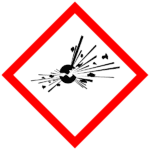Research Lab Autoclave Safety: Sealed Bottles are Bombs
By: Priorclave Limited
Category: Uncategorized

In August of 2001 a research lab autoclave was processing tightly capped 178 bottles using a 30-minute liquid load. The autoclave began making unusual sounds, so a trio of lab workers aborted the cycle and investigated. They opened the autoclave to discover a few bottles had burst. There was some lost liquid and a lot of broken glass—a mess, certainly, but far from the end of the world.
 Two of the lab techs stepped away while a third stayed at the autoclave to start clean up. She was still in her safety glasses, and had begun to put on her thermal suit when the rest of the bottles exploded. The rack that had been holding the bottles flew out of the autoclave, knocking her off her feet—possibly saving her life. Even though she was knocked away from the open autoclave, this tech was still struck be boiling liquid and flying Pyrex. She as hospitalized with first and second degree burns, as well as deep cuts across her arms and face. The explosion was so forceful that glass flew 25 feet and cut the other two workers, hospitalizing one.
Two of the lab techs stepped away while a third stayed at the autoclave to start clean up. She was still in her safety glasses, and had begun to put on her thermal suit when the rest of the bottles exploded. The rack that had been holding the bottles flew out of the autoclave, knocking her off her feet—possibly saving her life. Even though she was knocked away from the open autoclave, this tech was still struck be boiling liquid and flying Pyrex. She as hospitalized with first and second degree burns, as well as deep cuts across her arms and face. The explosion was so forceful that glass flew 25 feet and cut the other two workers, hospitalizing one.
Research Lab Autoclave Safety Best Practices
You should never tightly cap a bottles before autoclaving liquid or glassware. This might seem elementary—the changes in temperature and pressure in an autoclave obviously will cause fluids to expand—but some techs still persistently claim that sealed Pyrex bottles can reliably survive autoclaving. This simply is not the case (unless you’ve invested in an autoclave with a special air ballast feature).
While dramatic, explosions like these are rare. The real danger when operating the autoclave is the heat. Steam autoclaves are effective because steam transfers heat very effectively (far better than air and most lab surfaces)—and steam doesn’t know the difference between a flask and your face. Stay safe:
- Wear appropriate PPE (especially a face shield, steam apron, and steam gloves; the vast majority of autoclave injuries can be completely avoided with those three pieces of gear)
- Don\’t open the autoclave door until pressure has dropped to 0 psi
- Wait 10 minutes with the door cracked open before removing any materials from the autoclave
- Step to the side when opening the autoclave; keep your face and body clear of the door and any exiting steam
- Never autoclave a tightly capped bottle
- Always check to make sure the door is firmly closed

